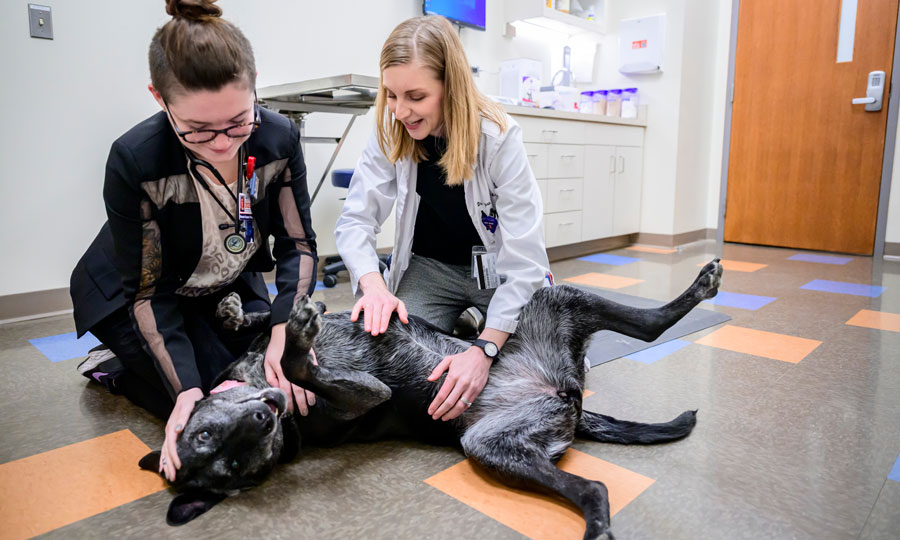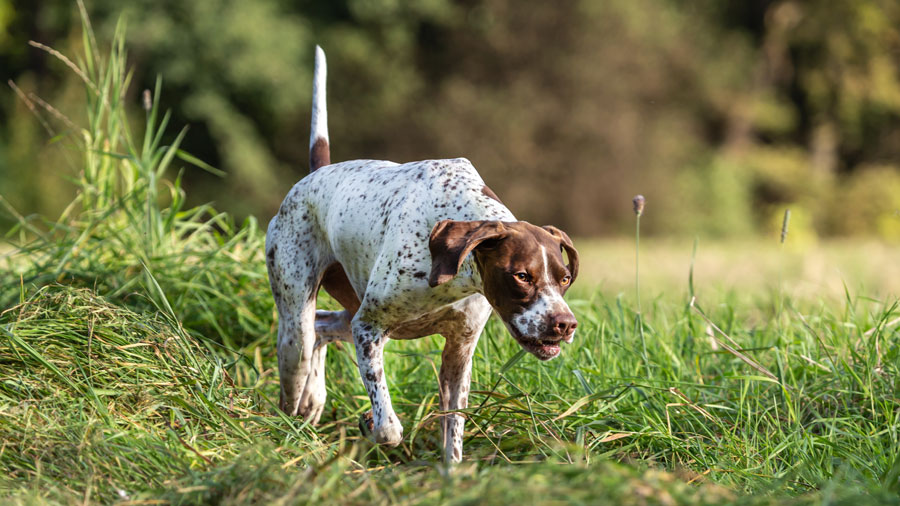Interdigital cysts are fairly common
Poor Ares was in pain. The three-year-old Doberman Pinscher had sores between his toes on all four paws when he came to see Dr. Jason Pieper, a veterinary dermatologist at the University of Illinois Veterinary Teaching Hospital in Urbana. Ares had been licking at the bumpy sores and some of them were bleeding.
![[one of Ares's feet]](https://vetmed.illinois.edu/wp-content/uploads/2021/04/pc-idcysts-ares-foot-300x200.jpg) Dr. Pieper’s diagnosis was interdigital cysts, meaning bumpy sores (cysts) located in the webbing between the toes (interdigitally). According to Dr. Pieper, these cysts are typically painful and affect the animal’s ability to walk. The diagnosis is based mainly on patient history and a physical examination along with observing cells under a microscope, but biopsies can be performed to confirm the diagnosis.
Dr. Pieper’s diagnosis was interdigital cysts, meaning bumpy sores (cysts) located in the webbing between the toes (interdigitally). According to Dr. Pieper, these cysts are typically painful and affect the animal’s ability to walk. The diagnosis is based mainly on patient history and a physical examination along with observing cells under a microscope, but biopsies can be performed to confirm the diagnosis.
Owners will typically report that their dog is licking at the area and not walking normally. One or more cysts can be present on any paw. Within one area of the paw, there can be multiple cysts in the skin that aren’t easily seen.![[another foot]](https://vetmed.illinois.edu/wp-content/uploads/2021/04/pc-idcysts-ares-foot2-300x200.jpg)
Interdigital Cysts: Unknown Cause
“Interdigital cysts like these are particularly painful because they will continue to rupture within the skin, producing more layers of cysts,” Dr. Pieper explains.
“We aren’t completely sure what causes interdigital cysts, although we tend to see them in dogs with shorter hair coats and often other health issues are present, such as environmental allergies,” Dr. Pieper says. Breeds that are susceptible include boxers, pit bulls, and Dobermann pinschers, especially those with obesity or thyroid problems.
One hypothesis regarding the cause of interdigital cysts is that the hair around the toes fractures because of the surface that the dog walks, and these fractured hairs lead to inflammation that causes cysts to form.
Interdigital Cysts: Treatment Options
There are three major options for treating interdigital cysts: surgery, CO2 laser, and medical therapy. Surgery completely removes the affected webbing and sutures the toes together for healing. This can help to completely remove the affected tissue, but it also changes the normal structure of the paws and can cause some orthopedic issues in the future.
The CO2 laser vaporizes the cysts from the webbing. A nice aspect of the CO2 laser is that you can vaporize just the affected tissue and allow the tissue to heal back in afterwards, which won’t alter the normal paw structure. Unfortunately, this can sometimes require multiple procedures in severe cases.
![[Ares outside]](https://vetmed.illinois.edu/wp-content/uploads/2021/04/pc-idcysts-pieper-ares.jpg) Medical therapies can include orally or topically administered anti-inflammatories, such as steroids, along with antibiotics since cysts are commonly infected with bacteria. Topical steroids are applied on the surface of the cyst and are a good first choice when there is only a single area of inflammation. Topical steroids are nice because they treat only the area affected and don’t cause side effects throughout the rest of the body. But in more severe cases, they are not able to penetrate deep enough, so oral anti-inflammatories are needed.
Medical therapies can include orally or topically administered anti-inflammatories, such as steroids, along with antibiotics since cysts are commonly infected with bacteria. Topical steroids are applied on the surface of the cyst and are a good first choice when there is only a single area of inflammation. Topical steroids are nice because they treat only the area affected and don’t cause side effects throughout the rest of the body. But in more severe cases, they are not able to penetrate deep enough, so oral anti-inflammatories are needed.
“While steroids are a good option, I prefer to use cyclosporine, which has fewer side effects,” says Dr. Pieper. “Unfortunately, cyclosporine can take more than a month to start working. Antibiotics are commonly administered for at least six weeks due to the severity of the infection.”
Happy Outcome for Ares
In Ares’s case, the best treatment option was to use the CO2 laser. The CO2 laser is a surgical treatment option that uses the energy of CO2 (carbon dioxide) to safely cut out the cysts. Using the laser, Dr. Pieper was better able to visualize the cysts to direct the laser only to the diseased tissue. The process involves little bleeding or nerve pain and heals relatively quickly.
Ares needed to have multiple laser treatments in order to remove the cysts on all four paws. After the treatments, his feet were bandaged and allowed to heal. Today, Ares is healthy, pain-free, and walking normally.
“Interdigital cysts are a fairly common problem we see all year long,” Dr. Pieper says. It is thought that having the dog wear booties when outside in cold and wet weather may prevent interdigital cysts by protecting the feet from rough, irritating surfaces and from the dampness that may contribute to infection.
Any instance of inflammation or excessive licking at the paws should be examined by a veterinarian right away.
“The earlier these are identified, the better chance there is to resolve these sores and prevent their spread,” Dr. Pieper emphasizes.
If you have questions about interdigital cysts, contact your local veterinarian.
By Beth Pieper




